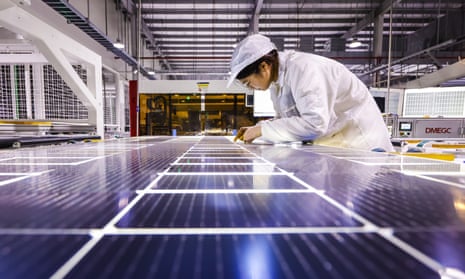Australia should develop its own solar photovoltaic (PV) manufacturing sector to avoid over-reliance on China for supply and tap into an industry with great potential, a report backed by the Australian Renewable Energy Agency (Arena) has found.
The decades-long expansion of the industry in China had driven the cost of solar panels down by more than two-thirds since 2016 alone. Chinese companies now dominate the global market and supply more than 90% of solar modules sold in Australia.
“Setting up viable, relevant and timely solar PV manufacturing in Australia can build resilience to future supply chain shocks, secure access to solar PV modules critical to meet Australia’s decarbonisation targets, and ensure implementation of more sustainable manufacturing practices,” the Silicon to Solar study said.
Creating a supply chain of 1 gigawatt PV yearly capacity – covering all steps from the polysilicon material to wafers, cells and then modules – would cost $3.2bn in subsidies over 10 years. A 5GW-sized industry roughly meeting existing Australian demand would cost $7.8bn in support over that period.
The report said a domestic solar industry would also create 4,000 well-paid jobs, reverse the drain of talent and intellectual property abroad and lure $2.9bn in upfront investment.
Renate Egan, the executive director for the Australian Centre for Advanced Photovoltaics and one of the report’s authors, said one impetus was that “the geopolitics is changing”, as tensions rise between China and the US. Australia’s own emissions goals also pointed to the need for Australia’s solar installations to at least quadruple.
“We can imagine a 20-gigawatt-a-year market,” Egan said. “If we were manufacturing for our market, that’s enough [size] to get the economies of scale.”
Australia’s current solar module production capacity is presently limited to just one firm, South Australia-based Tindo solar, at 160MW a year.
Tindo, one of the backers of the report, said last month it had plans to expand to 1GW at the cost of $90m to $100m but it would need support to do so.
Other ventures that governments have chosen to make national priorities include the Aukus nuclear submarines, which are predicted to cost $368bn out to the mid-2050s, while the Snowy 2.0 pumped hydro project will cost at least $12bn excluding $5bn-plus for transmission links.
China almost tripled its annual PV capacity in three years, reaching 817GW by the end of 2022, Bloomberg reported in January. Output of solar cells jumped 54% last year to 541GW but not enough to soak up excess capacity, while falling panel prices squeezed already-thin profit margins.
Egan said Australia must take a longer-term view.
“Only 5% of world energy comes from solar at the moment and we need that to grow tenfold,” Egan said. “So there is still a big opportunity ahead of it.”
after newsletter promotion
Of the stages of production, the report found the highest industry interest was in the refining of silicon and module manufacturing.
“The lowest cost, fastest entry is in module assembly, which is what Tindo do,” she said. “The next best place that Australia could and should play is in the silicon processing space.”
Australia’s world-leading solar research, centred at the University of New South Wales and the Australian National University, provided a “good working relationship with China”. Some of China’s biggest PV firms were led by people trained in Australia.
“We have open working relationships with nearly all of the big manufacturers so there’s a level of trust,” Egan said, adding Chinese companies may well be among investors in an expanding local sector.
The report noted other nations were boosting solar investments but those wouldn’t guarantee supplies for Australia.
“While major global economies such as the US, EU and India are beginning to expand their manufacturing capability, it is improbable that their production will meet their domestic demand and, even less probable, become available for export to Australia,” it said.
Guardian Australian approached the federal energy minister, Chris Bowen, for comment.
